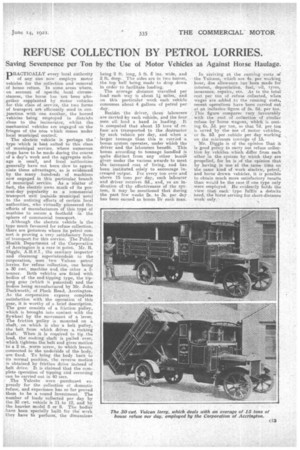REFUSE COLLECTION BY PETROL LORRIES.
Page 13

If you've noticed an error in this article please click here to report it so we can fix it.
Saving Sevenpence per Ton by the Use of Motor Vehicles as Against Horse Haulage.
PRACTICALLY every local authority of any size now employs motor vehicles for the collection and removal of house refuse. In some areas Where, on account of specific local circumstances, the horse has not been altogether supplanted by motor vehicles for this class of service, the two forms of transport art efficiently used in conjunction with one another, the horsed vehicles being employed in districts close to the incinerator, whilst the mechanical vehicles are engaged on the fringes of the area which conies under local municipal control.
The electric vehicle is perhaps the type which is best suited to this class of municipal service, where numerous stops have to be made during the course of a day's work and the aggregate mile. age is small, and local authorities generally have not been slow to appreciate these advantages, as is evidenced by the many hundreds of machines now engaged in this particular branch of municipal service. As a natter of fact, the electric owes much of its present-day popularity as a Commercial transport unit (outside municipal uses) -to the untiring efforts of certain local authorities, who virtually pioneered the efforts of manufacturers of this type oi machine to secure a foothold in the sphere of commercial transport. Although the electric vehicle is the type much favoured for refuse collection, there are instances where its petrol consort is proving a very satisfactory form of transport for this service. The Public Itlealth Department of the Corporation of Accrington is a case in point. Mr. R. Diggle, A.R.S.T., the sanitary inspector and cleansing superintendent to the corporation, uses two Vulcan •petrol . lorries for refuse collection, one being a 39 cwt. machine and, the other a 2tonner. Both vehicles are fitted with bodies of the end-tipping type, the tipping gear (which is patented) and the bodies being manufactured by Mr. John Duckworth; of :Neck Road, Accrington. As the corporation express complete satisfaction with the operation of this 'gear, it is worthy of a brief destiription. The gear consists of a friction pulley, which is bronght into contact with the flywheel 'by the movement of a lever. The friction pulley is mounted on a shaft, on which is also a belt pulley, the belt from which drives a. rocking Shaft. When it is required to tip the load, the rocking shaft is pulled over which tightens the belt and gives motion to a 2-in. Worm screw, to which levers, connected to the underside of the body, are. fixed. To bring the body badt to its normal position, the reverse motion is obtained by friction drive instead of belt drive. It is claimed that the complete operation of tipping arid reversing can he carried out in 40 Secs.
The Vulcahs were purchased expressly for the collection of domestic refuse, and experience has so far proved them to be a sound investment. The number of loads collected per day by the 30 cwt. vehicle is 11 to 12, and by the heavier model 8 or 9. The bodies have been specially built for the' work they have to perform, the dimensions
being 9 it. long, 5 ft. 6 ins, wide, and 2 ft. deep. The sides are in two halves, the top half being made to drop down in order to facilitate loading.
The average distance travelled per load each way is about 14 miles,. and on this particular work each vehicle consumes about 4 gallons of petrol per day.
Besides the driver, three labourers are carried by each vehicle, and the four -men all lend a hand in loading. It is computed that about 15 tons of refuse are transported to the destructor by each Vehicle per day, and when a larger tonnage than this is carried a bonus system operates, under which the driver and the labourers benefit. This bonus according to tonnage handled is quite distinct from any other bona given tinder the various awards to meet the increased cost of living, and has been instituted, solely to encourage increaed output. For every ton over and above 15 tons, per day, each labourer and driver receives .8d., and as an indication Of the effectiveness of the system, it may be. mentioned that during the past few weeks 2s. to 3s. per day has been earned as bonus BY eacti man. In arriving at the running costs of the Vuicans, which are 4s, per working hour, due allowance has been made for interest, depreciation, fuel, oil, tyres, insurance, repairs, etc. As to the total cost per ton of refuse collected, when wages are added to the running costs, recent operations have been carried out at an inclusive figure of Si. 8d per ton. This figure compares very favourably with the cost of collection of similar refuse by horse wagons, which is costing bs. 3d, per ton, so that 7d. per ton is saved by the use of motor vehicles, or 8s. 9a. per vehicle per day working on the minimum tonnage of 15.
Mr. Diggle is of the opinion That it is good policy to carry out refute collection by vehicles which differ from each other in the system by which they are propelled, for he is_of the opinion that by having in use at the same tinte on the same kind of work electric, petrol, and horse drawn vehicles, it is possible to obtain much more satisfactory results than would be the case if one type only were employed. He evidently holds the view that each type fulfils a definite need, the horse serving for short-distance work only.






































